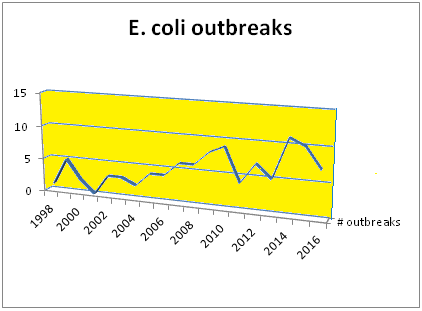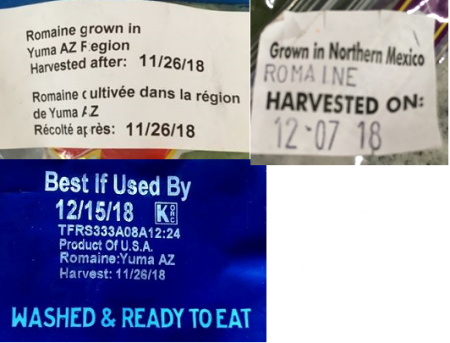Scientist and Farmers Dispute the FDA Conclusions Regarding the Reason for the Outbreak
The 2018 year in search by Google showed that romaine was the second most-searched food in 2018. With top terms like romaine recall; romaine lettuce recall; lettuce recall; lettuce e. coli; and e. coli romaine lettuce topping the list. Obviously, the number of outbreaks caused it.

The FDA Report
The largest outbreak of E. coliO157:H7 in the United States in over a decade left five people dead and sickened 210 others in 36 states. In November the FDA issued a report entitled Environmental Assessment of Factors Potentially Contributing to the Contamination of Romaine Lettuce Implicated in a Multi-State Outbreak of E. coli O157:H7. In this report the FDA emphasized the impact of environmental factors.
The outbreak strain of E. coli O157:H7 was found in water from three locations along a 3.5 mile stretch in an irrigation canal near Wellton in Yuma County, Arizona. Consequently, the FDA concluded that the irrigation water from the canal most likely led to the outbreak. The FDA mentioned that a large cattle feeding operation was nearby. While no obvious route for contamination from the cattle ranch to the irrigation canal was identified, and the E. coli strains responsible for the outbreak were not found in it, cattle ranch was viewed as a potential source of the contamination. The FDA investigators said E. coli could have reached the canal through groundwater seepage at the feedlot.
The FDA recommendations focus on the water quality and avoiding proximity cattle operations of green crops.
The dispute
In an interesting article Robert Anglen claims that the report conclusions fall apart under scrutiny and that the Yuma-area growers are skeptical of the FDA’s linking the irrigation water to an E. coli outbreak. For them, the theory is false? since the E. coli matching the strain that contaminated the romaine was found in the canal water both upstream and downstream from the cattle feedlot, while on the feedlot no matching strains were found.

Wellton canal near cattle ranch, from https://amp.azcentral.com/amp/2233659002
The article claims that while the FDA investigation found a maze of commingled supplies from 23 farms identified as “potential sources of contaminated lettuce.” Not all of the farms used water from the canal. Also, other farms using the canal to irrigate fields of leafy greens were not affected.
University of Arizona water quality specialist Channah Rock is among several scientists, growers, and researchers critical of the report. “It absolutely did more harm than good,” she said, and the FDA research did not go far enough. She criticized the FDA, saying that once they found the strain in the water, they concentrated their efforts on it. However, the test samples were too limited to provide conclusive data.
Many questions remain unanswered. How did the E. coli get upstream from the feedlot? How did the bacteria survive for weeks in a canal that moves up to 60 cubic feet of water per second? “It really doesn’t tell us anything more than the pathogen was in that canal,” Rock said. “I don’t think they found the source of the pathogen.”
Robert Anglen claims that months before the Yuma outbreak and hundreds of miles away, swimmers at Lake Wildwood in Northern California were sickened by E. coli that matched samples of the bacteria in the water to goose scat found on the beach. However, FDA spokesman Peter Cassell, said that the geese were not a factor in the FDA’s Yuma investigation and “at no point did cases in our traceback investigation trace to Wildwood.”
The Leafy Greens Marketing Agreement (representing 99% companies that ship and sell leafy greens in California and Arizona), presented a theory based on cold weather and dust. Temperatures below freezing can cause burn or blister on the leaves. Romaine is a delicate crop and the damaged leaves could have been susceptible to cells of E. coli picked up by wind and dusted over the fields, the association suggested.
Would water testing stop the outbreak?
In June the FDA Commissioner, Dr. Gottlieb that the outbreak emphasizes the need to implement the new FSMA rules. He called for better tracing procedures to make it easy to trace the product.
Dr. Gottlieb also points out the need for implementation of the water testing rules that will be required by FSMA. The act that was delayed would have required growers beginning this year to conduct specific water tests for pathogens. Gottlieb’s implicit suggestion was that the tests could have prevented the E. coli outbreak in Yuma.
However, researchers, scientists, and growers, dispute his assertion and say that the water tests already were done and in many cases went beyond the government standards. Trevor Suslow, (California Davis professor and vice president of food safety for the Produce Marketing Association) said that “The biggest propagation of misinformation has been the (water) tests… if they’d just tested the water,” the outcome would have been different is not true.
Rock agreed, saying industry imposed stringent water tests on its growers and “In this specific situation, all water quality data showed that it met or exceeded federal standards.”

Why is romaine lettuce susceptible to contamination?
The structure of romaine can provide protection for the bacteria because the lettuce head is shaped like a vase. The leaves stand upright in overlapping folds that spiral to a central core. The crevices in the crispy leaves offer shelter for bacteria, keeping them safe from ultraviolet light, wind, and rain that otherwise would kill them. Once bacteria enter into those microscopic nooks, they can’t be washed off.
Moving Forward
The FDA announced that romaine lettuce entering the market will now be voluntarily labeled with a harvest location and a harvest date or labeled as being hydroponically or greenhouse-grown. However, since labels are voluntary, they are not standardized. Each label looks different.
 The Arizona Leafy Green Agreement will enforce the tripling of the setbacks from animal enclosures, such as the cattle feeding operation, and to create 1,200-foot buffer zones; will conduct new environmental assessments after floods, frost or high winds; will increase the frequency and timing of cleaning and sanitizing harvest equipment. Products will be identified by lot numbers to aid in traceability.
The Arizona Leafy Green Agreement will enforce the tripling of the setbacks from animal enclosures, such as the cattle feeding operation, and to create 1,200-foot buffer zones; will conduct new environmental assessments after floods, frost or high winds; will increase the frequency and timing of cleaning and sanitizing harvest equipment. Products will be identified by lot numbers to aid in traceability.
Unfortunately, there is no guarantee the combined efforts of the FDA, CDC, growers, scientists and food researchers will stop the next outbreak.
